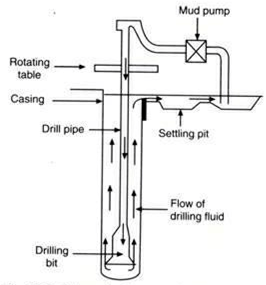This set of Construction & Building Materials Multiple Choice Questions & Answers focuses on “Site Exploration Methods”.
1. A square pit, known as _________ with side as about 1.50 m, is excavated upto a depth at which sufficiently hard soil is available.
a) Test pits
b) Probing
c) Test piles
d) Deep boring
View Answer
Explanation: Using Trail pits or Test pits, various Tata of the soil can be inspected, studied and classified accordingly. This method is useful when hard soil is available within a maximum depth of 1.50 metre.
2. _________ consists of driving either a hollow tube or a steel rod or an iron rod into the ground.
a) Trail pits
b) Test piles
c) Probing
d) Digging
View Answer
Explanation: In Probing, a hollow tube of diameter 35 mm to 50 mm is taken. The tube is driven into the ground 300 mm or so at a time. It is then withdrawn and the material caught in the slit is inspected.
3. The ____________ is the term used to denote a method in which case is driven into the ground and the material inside the casing is washed out and brought to the surface for inspection.
a) Deep boring
b) Percussion boring
c) Rotary drilling
d) Wash boring
View Answer
Explanation: The process of wash boring consists in driving an inner tube of diameter 25 mm to 50 mm, inside an outer tube of diameter 100 mm to 150 mm. Whereas, percussion boring and rotary drilling are the types of Deep boring.
4. Identify the given diagram below.

a) Percussion machine
b) Rotary drilling machine
c) Electrical resistivity method
d) Seismogram
View Answer
Explanation: In this process, a hollow tube is driven by rotary motion which cuts solid core. The water is used to facilitate the cutting process. The machine can be used either for soft or hard material.
5. The method in which 4 electrons are driven in the ground at equal distance apart and in a straight line upto a depth which the ground distance is to be measured.
a) Seismic refraction method
b) Geophysical method
c) Electrical resistivity method
d) Current extraction method
View Answer
Explanation: This method is based on the principle that each soil has different electrical resistivity, depending upon its water content, compaction and composition. For instance, the saturated soil will have lower electrical resistivity as compared to the loose dry gravel or solid rock.
6. The number of blows required to drive the penetrometer into the ground through a distance of 300 mm is measured which is known as _____________ of the soil.
a) Standard penetration resistance
b) Bearing power of soil
c) Maximum safe bearing capacity
d) Allowable bearing pressure
View Answer
Explanation: The bearing capacity and the other engineering properties of certain types of soil are they known by referring to the curves correlating Standard Penetration Resistance or SPT and the corresponding characteristics of soil. The values of SPT of soil and different depths are determined.
7. The resistance of the soil with depth is measured by means of a tool known as the _______
a) Seismometer
b) Potentiometer
c) Penetrometer
d) Ammeter
View Answer
Explanation: The penetrometer is used under static or dynamic loading which may consist of a sampling spoon, a cone or tool of other shape. The penetrometer is driven in the ground with the help of blows from a 650 N weight falling from a height of 750 mm.
8. Identify the given diagram below.

a) Post-hole auger
b) Screw auger
c) Shell auger
d) Rod
View Answer
Explanation: The length of the tube is about 1.50 M and it is provided with a Jaws at the end so that it can be suitably explore or dig the ground easily. The auger is work by applying leverage at the top.
9. The shock waves so produced travel down in the sub soil strata and get reflected after striking a hard rock surface below and recorded by the instrument known as ___________
a) Microphone
b) Geophone
c) Receiver
d) Sensors
View Answer
Explanation: A number of geophones are arranged along a line. Some of the waves, known as direct or primary waves, are picked first buy Geophones. The Other waves which travel down through the soil get reflected after striking a hard rock surface below.
10. What is the average depth of a Test pit?
a) 10 m
b) 2 m
c) 1.50 m
d) 15 m
View Answer
Explanation: Test Pit is excavated up to a depth about 1.50 m at which sufficiently hard soil is available. The various data of soil can be inspected, studied and classified accordingly. This method is useful when hard soil is available within a maximum depth of 1.50 m.
Sanfoundry Global Education & Learning Series – Construction and Building Materials.
To practice all areas of Construction & Building Materials, here is complete set of 1000+ Multiple Choice Questions and Answers.
If you find a mistake in question / option / answer, kindly take a screenshot and email to [email protected]
- Check Civil Engineering Books
- Practice Civil Engineering MCQs
- Apply for Civil Engineering Internship
- Check Construction and Building Materials Books
